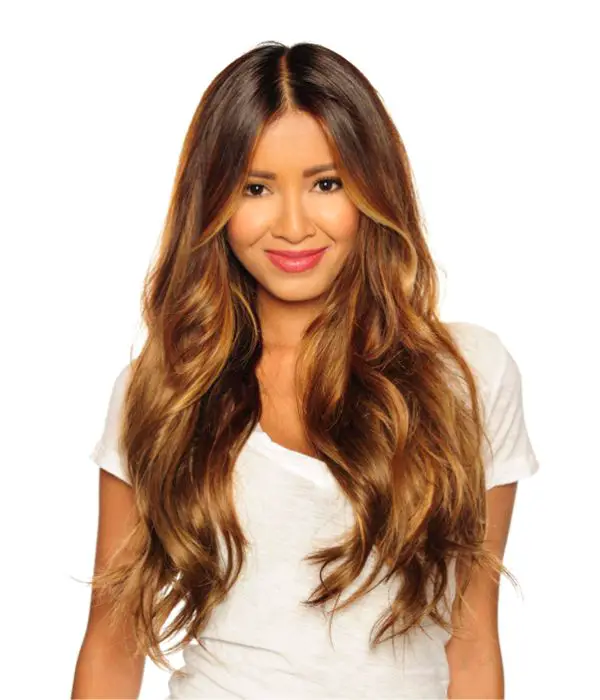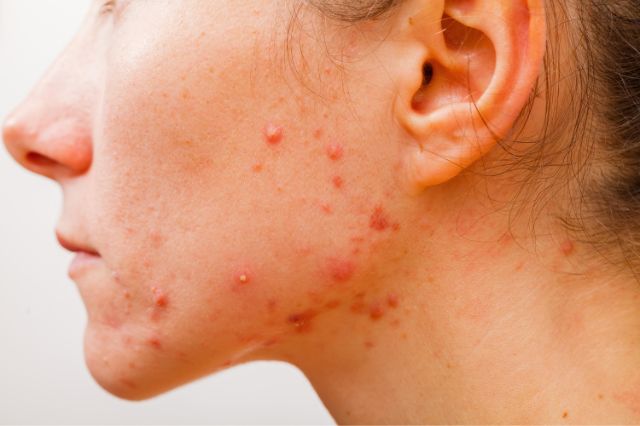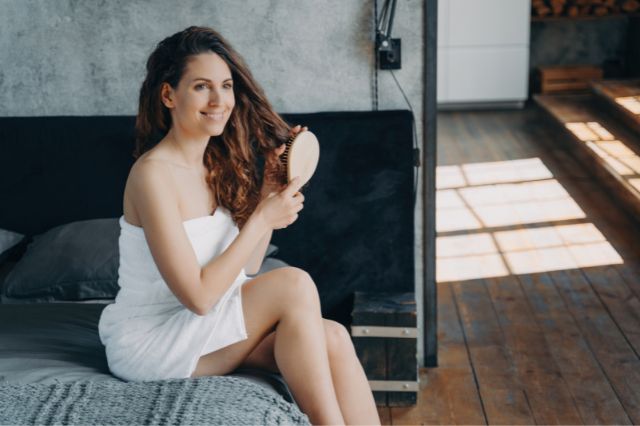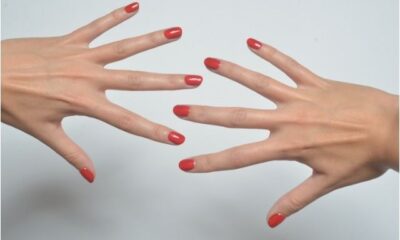Beauty
5 Unique Features to Check in Clip-in Extensions

Clip-in extensions are a choice for many women because they are relatively easy to apply and remove, and they offer a lot of flexibility in terms of style. Around 34 percent of women say that they regularly use hair extensions as part of their beauty regime.
If you are thinking about trying clip in extensions, or are simply curious about what sets them apart from other types of extensions, here are five unique features to look for:
1. Easy to Apply and Remove
One of the main reasons women choose clip-ins is because they are effortless to apply and remove. You can do it at home in just a few minutes, and you don’t need any special tools or products.
Here are the basic steps:
-Start with clean, dry hair.
-Open the clips on the extensions.
-Position it at the root of your hair, and then snap the clips closed.
-Repeat until all the pieces are in place.
Open the clips and slide them out of your hair to remove them.
Clip-in hairs are a great option if you are looking for something temporary or want to change the look without making a permanent commitment. They are also less expensive than other hair extensions, and they are relatively easy to apply and remove.
2. Offer a Lot of Flexibility in Terms of Style
When you choose these clip-ins, check for the ones that offer a lot of flexibility in terms of style. You can wear it in unique styles, depending on the occasion. For instance, you can go for a sleek and straight look or choose to curl them for a more glamorous look.
They should also be comfortable to wear. In addition, they should not cause any irritation or pain, even after wearing them for long hours.
Check the reviews to see what other people have to say about the comfort level of the extensions. Also, make sure that they are easy to put on and take off. You should be able to clip it without any help.
3. Relatively Inexpensive
It is vital to compare apples to apples when investigating the cost of hair extensions. The cost may vary depending on the hair extensions, their source, and their quality. Generally speaking, clip-in extensions are less expensive than other hair extensions like tape-ins, sew-ins, or micro-links.
4. Available in a Range of Colors and Textures
You can choose your favorite color and texture when buying clip-in hair extensions. There are many colors available, so you can match your hair color or try a new shade. In addition, you can choose from various textures, including straight, wavy, and curly.
5. Can Be Worn for up to a Longer Period
Lastly, check to see how long the clip-ins can be worn. The average person will want to be able to wear them for several months, if not longer. You should also find out if any special care instructions come with these.
Conclusion
Clip-ins are an excellent way to add length, volume, and even color to your hair without any commitment. You must check for quality and brand reputation before purchasing.
Beauty
How to Test for Acne


Acne is the most common skin issue in the United States, affecting an estimated 50 million people. Although most prevalent in teenagers and adolescents, adult acne is a problem affecting men and women throughout their adult lives.
So, how do you know if you suffer from acne, and how do you find out what is causing it? Let’s take a closer look.
What is acne?
Acne is a skin condition that predominantly leads to spots and oily skin. It most typically occurs on the face, back, and chest. Acne is often linked to a change in hormone levels during puberty but can start at any age.
Some people only experience mild symptoms of acne that do not require treatment, whereas others struggle with more severe issues.
What are the main symptoms of acne?
Although everyone’s skin is different, some of the most common symptoms of acne are:
- Crusting of skin bumps
- Cysts
- Papules (small, red bumps)
- Pustules (small, red bumps that contain white or yellow pus)
- Redness around skin eruptions
- Scarring of the skin
- Whiteheads
- Blackheads
The symptoms of acne most commonly occur on the face, although they can also manifest themselves on the shoulders, back, arms, chest, and buttocks.
How is acne diagnosed?
If you suspect that you may have acne, you can make an appointment with your doctor, who will be able to give you an official diagnosis. In most cases, they can do this simply by examining the skin without the need for any testing.
Alternatively, you could book an appointment with a dermatologist, although this is unlikely to be covered by your health insurance.
What tests are available for acne?
If you struggle with chronic acne and would like to find out more about what is causing your skin to break out, you might want to consider requesting a blood test for acne.
Although this can be carried out by your doctor, it would be better to work with dermatologists and skin experts who can administer an in-depth test to see what is going on underneath the surface of your skin.
There are lots of different biomarkers that can be checked to see what is causing the acne on your skin, such as:
- Blood glucose
- Kidney function
- Electrolytes
- Inflammation
- Vitamins and minerals
- Liver function
- Thyroid
- Hormones including testosterone, estrogen and progesterone
- Gallbladder function
It is highly unlikely that your doctor will check all these elements of your health when doing a blood test as it is expensive to do. However, this can leave you with even more unanswered questions. However, when you undergo full testing, you can find the root cause of your acne and make any necessary changes to your lifestyle, diet, and skincare routine.
You can order acne health skin care home test kits that are delivered directly to your doorstep, which require you to take a sample and post it back to the lab. Alternatively, if you do not feel comfortable doing this, you can make an appointment with a private clinic.
What triggers acne outbreaks?
There are lots of things that can trigger an acne breakout, including:
- Hormonal changes such as puberty, menstrual periods, pregnancy, birth control pills, and menopause.
- Certain medications, such as steroids and testosterone.
- Birth control devices such as drug-containing IUDs.
- Excessive touching of the skin.
Although many people believe that a poor diet can contribute to spots, there is little evidence to suggest that eating sugary foods such as chocolate and candy causes spots.
What are the best treatments for acne?
Depending on the severity of your symptoms, there are several treatment options available. For mild cases, it can be a good idea to start with a good skincare regime that includes cleansing, moisturizing and gentle exfoliation.
For more stubborn spots and blemishes, over-the-counter treatments that contain salicylic acid or benzoyl peroxide can be effective. However, these can cause redness, drying, or excessive peeling of the skin in some people.
Lastly, for those who have severe symptoms of acne, there are several treatments that your doctor may be willing to prescribe, such as oral and topical antibiotics and prescription formula sulfur, resorcinol or salicylic acid.
Final thoughts
Acne, both in adolescence and adulthood, can have a seriously detrimental effect on your self-esteem. Fortunately, you do not need to suffer in silence as there are tests and treatments available, with options for all ages and skin types.
Beauty
The Top 10 Most Popular Beauty Treatments Available Today


In a world where self-expression is revered, the beauty industry has become a vibrant canvas for individuals seeking to enhance their natural allure. The allure of a youthful appearance, in particular, has fueled the popularity of various beauty treatments. Let’s embark on a journey through the top 10 most sought-after beauty treatments, with our spotlight on the reigning champion: Botox.
1. Botox: The Timeless Elixir
Botox takes the lead as the go-to beauty treatment, which https://dermatologyandlasergroup.com/ offers. This non-invasive procedure involves injecting a purified form of botulinum toxin into the skin to temporarily reduce the appearance of fine lines and wrinkles. The magic lies in its ability to relax facial muscles, providing a smoother and more youthful complexion without the need for surgery.
There are lots of different types of Botox:
- Traditional Botox: The classic go-to, perfect for reducing forehead lines, frown lines, and crow’s feet.
- Botox for Brow Lift: Elevate your brows without surgery, achieving a refreshed and more youthful appearance.
- Botox for Bunny Lines: Target those adorable nose wrinkles with precision injections for a smoother profile.
- Botox for Jaw Slimming: Say goodbye to a square jawline by relaxing the masseter muscles, creating a slimmer facial contour.
- Botox for Hyperhidrosis: Combat excessive sweating by strategically injecting Botox in areas like the underarms.
- Botox for Migraine Relief: Beyond beauty, Botox can alleviate chronic migraines when injected into specific headache trigger points.
- Botox Lip Flip: Enhance your pout by subtly flipping the upper lip, creating a fuller and more defined look.
- Micro-Botox: A delicate approach, involving tiny injections for overall skin rejuvenation without a frozen look.
- Botox for Neck Bands: Smooth out vertical neck bands, restoring a youthful neck profile with targeted injections.
- Preventative Botox: Embrace a proactive approach by starting Botox early to prevent the formation of wrinkles over time.
2. Dermaplaning: A Silken Touch to Radiance
Imagine a treatment that not only removes dead skin cells but also unwanted facial hair, leaving your skin velvety smooth. Dermaplaning achieves just that. This exfoliating technique, carried out by a skilled aesthetician, employs a surgical scalpel to gently scrape away dead skin, revealing a radiant complexion beneath.
3. Microdermabrasion: Polishing Perfection
For those seeking a refined glow, microdermabrasion is a game-changer. This non-invasive procedure employs a special machine to exfoliate the outer layer of skin, diminishing imperfections like fine lines, acne scars, and sunspots. The result? A polished canvas that reflects the light in all the right ways.
4. Chemical Peels: Unveiling Fresh Beginnings
Chemical peels offer a transformative journey, shedding old skin to reveal a revitalized complexion. By applying a chemical solution to the skin, these treatments exfoliate the outer layer, encouraging the growth of new, healthier skin. From mild to deep peels, this procedure can address various skin concerns, from acne scars to uneven pigmentation.
5. Laser Hair Removal: Silky Smooth Confidence
Bid farewell to razors and waxing with the enduring benefits of laser hair removal. This procedure employs concentrated beams of light to target and eliminate unwanted hair follicles, resulting in long-lasting smoothness. Say goodbye to the hassle of frequent shaving and hello to newfound confidence.
6. HydraFacial: Hydration Infusion
HydraFacial, the refreshing oasis for your skin, combines cleansing, exfoliation, extraction, hydration, and antioxidant protection in a single treatment. This multi-step process rejuvenates the skin, leaving it hydrated, plump, and radiant. It’s the perfect pick-me-up for those craving instant luminosity.
7. Injectable Fillers: Sculpting Beauty
Injectable fillers have become an artistic tool in the hands of skilled practitioners, sculpting and enhancing facial features. From plumping lips to defining cheekbones, these fillers provide a non-surgical approach to achieving a harmonious and youthful appearance.
8. Platelet-Rich Plasma (PRP) Therapy: The Healing Elixir
Harnessing the body’s natural healing process, PRP therapy involves drawing a small amount of the client’s blood, processing it to concentrate the platelets, and then injecting it back into the skin. This promotes collagen production, improving skin texture and elasticity. It’s a holistic approach to rejuvenation with results that speak for themselves.
9. Ultherapy: The Non-Surgical Facelift
For those seeking a lift without going under the knife, Ultherapy offers a non-invasive solution. This treatment uses ultrasound technology to stimulate collagen production, resulting in tighter and firmer skin. It’s the ideal choice for those looking to defy gravity and turn back the clock.
10. CoolSculpting: Sculpting Your Body, One Freeze at a Time
CoolSculpting, the innovative fat-freezing technique, provides a non-surgical alternative to liposuction. By targeting and freezing fat cells, the body naturally eliminates them over time. It’s a personalized sculpting experience that allows individuals to contour their bodies with precision.
In Conclusion: Elevate Your Beauty, Your Way
The world of beauty treatments is a vast landscape, offering a myriad of options to enhance your natural radiance. From the timeless allure of Botox to the sculpting prowess of injectable fillers, each treatment has its unique charm. As you navigate this realm, remember that beauty is a personal journey, and these treatments are simply tools to help you express the most authentic version of yourself. Embrace the transformative power of these treatments, and let your beauty shine.
Beauty
Ultimate Guide for Building a Daily Hair Care Routine


Just like how you take care of your skin, you also need to pay attention to your hair to keep it looking shiny and healthy.
It’s important to have a daily routine for your hair to keep it in the best shape possible. If you have blonde hair, using the right products, like blonde shampoo, is essential.
In this guide, we’ll outline the simple steps and products required for a daily hair care routine that will help your hair stay strong and look beautiful. We’ll cover everything from washing to styling.
Kindly completely read this guide, and don’t miss any crucial steps for better hair!
Step 1: Understanding Your Hair Type
The first thing to do for healthy hair is to figure out what kind of hair you have. Hair can be thin and straight or thick and curly, and each type needs different things to stay healthy. Knowing what kind of hair you have will make it easier for you to pick the right shampoos, conditioners, and styling stuff.
Here are various kinds of hair that you should be aware of:
Straight Hair: Usually, when your hair is straight, it tends to get oily more easily. If you don’t take good care of it, it can become flat and greasy quickly.
Curly Hair: Many folks who have curly hair often find that their hair is prone to becoming dry and getting frizzy. To keep it looking good and bouncy, you need to make sure it gets enough moisture and special attention.
Wavy Hair: Wavy hair is like a mix of straight and curly hair. Sometimes, you might need special products to make it look neat and easy to handle.
Coarse Hair: Thick and rough hair can be hard to handle. To make it soft and healthy, you need to use a deep conditioner.
Fine Hair: Thin hair is fragile and can get hurt easily. It likes using light products that add volume.
Step 2: Choose the Right Products
Now that you’ve figured out what kind of hair you have, it’s time to pick the best products for it. Here are the things you need:
Shampoo:
Choose a mild shampoo without sulfate that’s right for your hair. If your hair gets oily quickly, use a clarifying shampoo. If your hair often feels dry, use a shampoo that adds moisture. Wash your hair every 2-3 days or when it starts to feel dirty.
Conditioner:
Conditioner is like a must-have for your hair. It helps make your hair soft and easy to handle. Make sure the conditioner you pick matches your shampoo. Put it on your hair from the middle part to the ends. Don’t put it on your scalp because that can make your hair too oily.
Hair Mask:
To make your hair super moisturized and healthy, apply a special hair mask that gives deep nourishment once a week. This is extra important if your hair is damaged or really dry.
Leave-In Conditioner:
Leave-in conditioners are like magic for your hair. They make it easier to comb through, and they give your hair extra moisture. If your hair is curly or tends to get frizzy, these conditioners are especially great for you.
Heat Protectant:
If you often use hot styling tools on your hair, it’s a good idea to get a heat protectant spray. This spray helps to keep your hair safe from the harm caused by the heat.
Styling Products:
Pick hair products like serums, mousses, or hair sprays that work well for your hair and the hairstyle you want.
Step 3: Washing Your Hair
Washing your hair is really important for keeping it healthy. Let’s see how to do it the right way:
Wet Your Hair: To begin, make sure your hair is all wet with warm water. Don’t use hot water because it can remove the natural oils from your hair.
Shampoo: Put a little bit of shampoo on your head. Use your fingers to gently rub it in, but don’t scratch with your nails because that can hurt your scalp. Wash it off with warm water.
Condition: Put conditioner on your hair from the middle part to the ends. Wait for a few minutes to let it do its job. After that, wash it off with cool water to make your hair smooth and shiny.
Pat Dry: After you’ve washed your hair, use soft, clean towels to gently pat it dry. Don’t rub it too hard because wet hair can easily get damaged.
Step 4: Brushing and Detangling
Taking care of your hair is really important. To do that, you need to use a wide-toothed comb or a special brush to avoid damaging your hair. Start combing from the ends and slowly move up to the top, making sure to get rid of any knots and tangles.
Step 5: Heat Styling
If you use hot tools on your hair, like hair dryers or straighteners, make sure to keep your hair safe. Use a spray that protects your hair from the heat. When you blow-dry your hair, choose the lowest heat setting. If your hair is curly, use a special attachment called a diffuser. And if you’re using straighteners or curling irons, try to use the lowest temperature that still gets the job done so you don’t harm your hair with too much heat.
Step 6: Treat Your Scalp
A strong and healthy scalp is like the soil for your hair to grow well. You can make your scalp happy by giving it a gentle massage using oils like coconut, jojoba, or tea tree. Massaging your scalp this way can make your blood flow better and help your hair grow better, too.
Step 7: Protect Your Hair from Environmental Damage
Sun, dirty air, and bad weather can hurt your hair. Keep it safe by wearing hats, using hair products with sun protection, and keeping your hair moisturized. Try protective hairstyles and regular haircuts for healthy hair.
Step 8: Regular Trims
Getting regular trims is important to stop your hair from splitting and to keep your haircut looking nice. You should aim to have a haircut every 6-8 weeks or whenever your hair starts looking a bit messy. This way, your hair will stay looking nice and healthy.
Step 9: Nighttime Care
Think about using a smooth silk or satin pillowcase. It helps stop your hair from getting damaged by reducing rubbing. You should also try braiding your hair or putting it in a loose bun before bedtime to keep it from getting tangled while you sleep.
Step 10: Nutrition and Hydration
The food you eat can change the way your hair looks. Eating a well-rounded diet with lots of vitamins, minerals, and protein is important for keeping your hair strong and lively. Make sure to drink enough water to keep your hair moisturized, too.
Step 11: Stress Management
Stress can make your hair not as healthy. To keep your hair in good shape, try doing relaxing things like yoga, meditation, or taking slow, deep breaths.
Step 12: Regular Checkups
If your hair is causing you problems, like too much hair falling out, dandruff, or an itchy head, it’s a good idea to see a skin doctor or a hair expert. They can give you advice and treatments that are just for you.
Last tip
In brief, creating a daily hair care routine will be fruitful for your hair health. You need to know what type of hair you have and use the right products.
You can make your hair look nicer by following the instructions in this article. So, start today and enjoy the benefits of strong, shiny, and healthy hair that boosts your confidence and complements your overall well-being.
Do you have any specific questions or concerns related to hair care that you’d like to discuss? Drop them in the comments below!
Thank you for reading!
Please share these tips with your friends as well.
-



 Captions3 years ago
Captions3 years ago341 Sexy Captions to Fire Up Your Instagram Pictures
-



 Captions3 years ago
Captions3 years ago311 Night Out Captions for Instagram and Your Crazy Night
-



 Captions3 years ago
Captions3 years ago245 Saree Captions for Instagram to Boost Your Selfies in Saree
-



 Captions3 years ago
Captions3 years ago256 Best Ethnic Wear Captions for Instagram on Traditional Dress
-



 Captions3 years ago
Captions3 years ago230 Blurred Picture Captions for Instagram
-



 Captions3 years ago
Captions3 years ago275 Deep Captions for Instagram to Express Your Thoughts
-



 Quotes3 years ago
Quotes3 years ago222 Nail Captions for Instagram to Showcase Your Fresh Manicure
-



 Captions3 years ago
Captions3 years ago211 Laughing Captions for Instagram | Laughter Is the Best Medicine







